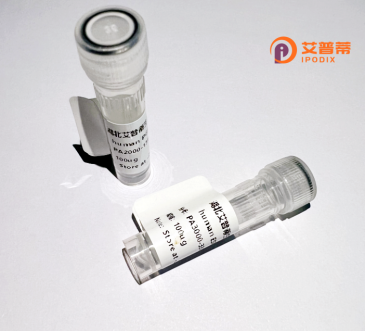
| 纯度 | >90%SDS-PAGE. |
| 种属 | Human |
| 靶点 | C20orf117 |
| Uniprot No | O94964 |
| 内毒素 | < 0.01EU/μg |
| 表达宿主 | E.coli |
| 表达区间 | 1-518aa |
| 氨基酸序列 | MWDWAPTTSLQEVNKTVLVFALTQHTDQGGRPECALSVISTNNDVSSSVLRRTKSVSSMSEFESLLDCSPYLAGGDARGKKLPNNPAFGFVSSEPGDPEKDTKEKPGLSSRDCNHLGALACQDPPGRQMQRSYTAPDKTGIRVYYSPPVARRLGVPVVHDKEGKIIIEPGFLFTTAKPKESAEADGLAESSYGRWLCNFSRQRLDGGSAGSPSAAGPGFPAALHDFEMSGNMSDDMKEITNCVRQAMRSGSLERKVKSTSSQTVGLASVGTQTIRTVSVGLQTDPPRSSLHGKAWSPRSSSLVSVRSKQISSSLDKVHSRIERPCCSPKYGSPKLQRRSVSKLDSSKDRSLWNLHQGKQNGSAWARSTTTRDSPVLRNINDGLSSLFSVVEHSGSTESVWKLGMSETRAKPEPPKYGIVQEFFRNVCGRAPSPTSSAGEEGTKKPEPLSPASYHQPEGVARILNKKAAKLGSSEEVRLTMLPQVGKDGVLRDGDGAVVLPNEVGGWDLSFLLVGGVSI |
| 分子量 | 82.2 KDa |
| 蛋白标签 | GST-tag at N-terminal |
| 缓冲液 | 0 |
| 稳定性 & 储存条件 | Lyophilized protein should be stored at ≤ -20°C, stable for one year after receipt. Reconstituted protein solution can be stored at 2-8°C for 2-7 days. Aliquots of reconstituted samples are stable at ≤ -20°C for 3 months. |
| 复溶 | Always centrifuge tubes before opening.Do not mix by vortex or pipetting. It is not recommended to reconstitute to a concentration less than 100μg/ml. Dissolve the lyophilized protein in distilled water. Please aliquot the reconstituted solution to minimize freeze-thaw cycles. |
以下为3篇涉及C20orf117(FAM210A)蛋白研究的参考文献摘要:
1. **文献名称**:*FAM210A is essential for mitochondrial function in myogenic differentiation*
**作者**:Zhang Y et al. (2018)
**摘要**:研究发现C20orf117(FAM210A)蛋白在骨骼肌分化中通过调控线粒体蛋白合成维持能量代谢,敲低后导致肌管形成障碍和线粒体功能缺陷。
2. **文献名称**:*FAM210A mediates mitochondrial translation regulation linked to skeletal muscle maturation*
**作者**:Lee J et al. (2020)
**摘要**:揭示FAM210A直接结合线粒体核糖体,调控mRNA翻译效率,其缺失会引发肌细胞线粒体呼吸链复合体组装异常。
3. **文献名称**:*The role of FAM210A in cancer cell proliferation and invasion*
**作者**:Wang H et al. (2021)
**摘要**:在肺癌模型中证明FAM210A通过激活PI3K/AKT通路促进肿瘤生长和转移,高表达与患者预后不良相关。
4. **文献名称**:*Hypoxia-induced FAM210A regulates ER stress in cardiomyocytes*
**作者**:Chen L et al. (2019)
**摘要**:发现FAM210A在缺氧应激下调控心肌细胞内质网应激反应,抑制其表达导致细胞凋亡增加。
提示:若需具体实验细节,建议通过PubMed输入基因别名(如FAM210A)检索最新文献。
**Recombinant Human C20orf117 Protein: Background Overview**
The human C20orf117 protein, encoded by the *C20orf117* gene (Chromosome 20 Open Reading Frame 117), is a relatively understudied protein with emerging roles in cellular processes. Located on chromosome 20q11.21, its gene structure and regulatory mechanisms remain partially characterized. Although functional annotations are limited, bioinformatics analyses suggest potential involvement in protein-protein interactions, cellular adhesion, or intracellular trafficking. The protein is predicted to contain conserved structural motifs, including potential phosphorylation and glycosylation sites, hinting at post-translational regulatory mechanisms.
Interest in recombinant C20orf117 stems from its differential expression observed in certain cancers and neurological disorders, suggesting a possible biomarker or therapeutic target. Recombinant production, typically using bacterial or mammalian expression systems, enables functional studies such as antibody development, interactome mapping, and pathway analysis. Recent studies have linked it to modulating autophagy or ER stress responses, though mechanistic details remain unclear.
Current research focuses on elucidating its physiological roles, binding partners, and disease associations. Advances in structural biology and omics technologies are expected to clarify its molecular functions, paving the way for translational applications in diagnostics or targeted therapies. Despite its enigmatic nature, C20orf117 represents a promising candidate for unraveling novel cellular pathways and disease mechanisms.
×